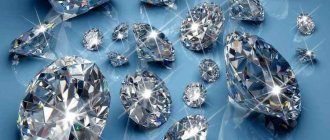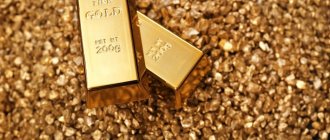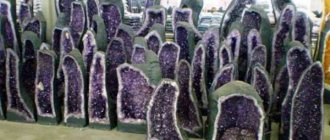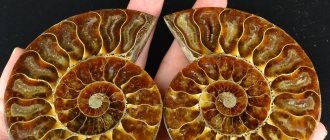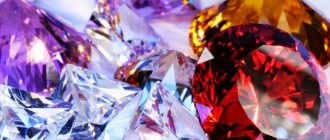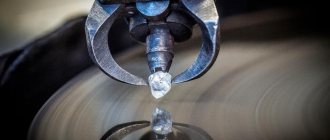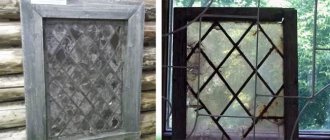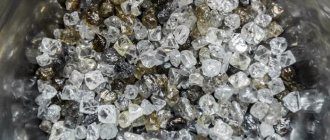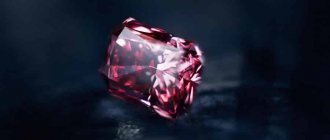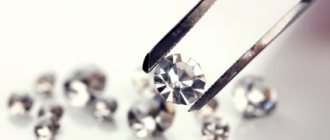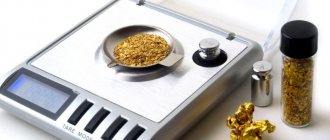What is amber and what are its properties?
Amber is found in places where many coniferous trees previously grew, and this is not surprising, because amber is nothing more than their fossilized resin.
However, in this precious world there are exceptions - blue Dominican amber, which was formed from larch resin. On different continents and even in different nationalities, the name of the stone was different, but the word “amber” itself was presumably borrowed from the Lithuanian language. Poets also attribute many lyrical comparisons to the stone, for example, “tears of the sea” or “gift of the sun.” The properties of amber are not quite typical for a semi-precious mineral.
First of all, it lacks the ability to form crystals and is essentially a framework amorphous polymer. It is easy to process and polish, for which it is very loved by craftsmen who work with minerals. It does not refract light, as many other semi-precious stones do, and does not change its color when light hits it from a different angle. What is noteworthy is that this mineral is quite flammable; a flame of a match is enough for it to ignite and begin to release a pleasant aroma. When rubbed, amber becomes electrified, and when exposed to air it reacts with oxygen - it oxidizes, becoming less bright over time and becoming friable.
PURCHASE AND CARE
When buying amber, you must remember that this mineral is easy to fake: sometimes imitations are very beautiful.
Artificial gems are made from natural and synthetic resin, plastic and glass.
Buying amber
How to distinguish natural from pressed
One way to fake a solar mineral is by pressing amber chips. Such a stone (ambroid) will still be natural and much better than a plastic fake, but when a pressed gem is passed off as a solid natural mineral, the price is greatly inflated.
Origin of amber
Even ancient scientists came to the conclusion that amber is of plant origin. The Roman scientists Pliny and Tacitus pointed out the specific plant smell when rubbing the mineral, as well as the fact that insects and small animals were often found in the stone. Tacitus believed that amber was the frozen juice of plants that fell into the sea.
The 16th century German mineralogist Agricola believed that the mineral was of inorganic origin.
In the 18th century, the theory of plant origin was confirmed by the Swede Linnaeus, a famous botanist. A little later, Russian scientist Mikhail Lomonosov came to the same conclusion.
Scientists have proven that the amber stone that is now mined was formed more than 40 million years ago from amber-bearing pines, that is, it is of plant origin. At that time they grew in North America, Greenland, and Eurasia. Under the influence of climatic conditions, resin was released, which petrified and fell over the years. The coming sea carried her away from the shores.
Varieties of amber
To classify amber, experts pay attention to its molecular structure and degree of transparency. Often in stones you can find frozen particles of plants, insects and other organisms; such stones with reminders of the past are called inclusions and they are of great value to paleontologists. In general, a distinction is made between fossil and semi-fossil amber.
The stone that belongs to fossils is also called succinite. This species accounts for up to 98% of all Baltic amber. An important feature of the classification is the degree of fragility, which is determined using a special tool - a microhardness tester in grams. Brittle resins - gedanite, have a fragility in the range of 20-50 g, viscous - succinite, more than 200 g. The fossil is also characterized by the degree of its transparency, which is formed from the number of voids present in it. On this basis, amber is classified as follows:
- foamy – opaque with cavities up to several mm;
- bone - opaque, ivory in color, density 900,000 sq.mm;
- bastard – opaque with a density of 2500 sq. mm;
- cloudy – translucent, density 600 sq.mm;
- transparent - without voids (the highest quality stone).
The color of amber can be not only orange-yellow; chemical compounds trapped inside the resin can give the finished fossil completely different colors of the spectrum.
I'm so versatile...
The most famous and numerous type of amber is Baltic .
Baltic amber with inclusions
Varieties and types of amber can be classified:
- By color.
- By transparency (transparent, cloudy, bone, bastard, foamy).
- According to the chemical composition.
- At the place where the stone was mined. Burmese stones are called birmite (burmite). They are opaque; color ranges from almost white to brown.
Chemists classify amber according to the structural features of its “molecular skeleton”.
Amber with inclusions of air or water bubbles is called bastard. It is cheaper than other types.
How is amber mined?
Many people are interested in how amber is mined, but what is noteworthy is that although the extraction of the mineral has been going on for many years, the technical means for developing deposits have not changed over a long period. Only 19th century. During the period of technology development, new methods and equipment appeared that made it possible to significantly increase the volume of extracted raw materials. Along with the improvement of the process, it was possible to reduce the harm from mining to the environment.
Water extraction
Amber can be mined in water or on land. If the stone is mined on the water, then this can be done by hand picking after high tide, loosening the soil under water with long poles and industrially lifting the soil from the bottom of the sea. Collecting stone after high tide is one of the most ancient ways of extracting amber, but such stones are usually small in size and have a dull and dark color. Prospectors can either lift stones on the shore, which requires efficiency, or catch amber brought in by the tide, using special equipment.
In good weather conditions - bright sunshine and calm water - you can also see the stones lying on the bottom. Then the miners loosen the soil underwater with long poles and catch the minerals that have risen to the surface. Mining is also carried out on an industrial scale, when soil supposedly rich in this mineral is lifted from the bottom, sending it further for sifting, sorting and enrichment. However, this method is in low demand due to its high cost and significant damage to nature.
Land mining
To extract amber using this method, a mine or quarry method is used. However, mine mining is currently practically not used due to its technical disadvantage, but open-pit mining is still in demand. It consists of several stages:
- exploration work at a depth of 5-60 m;
- removal of waste rock using special equipment;
- removal of fertile soil;
- processing the rock to identify minerals;
- cleaning and sorting of stone.
This process is also not cheap, so the natural gems obtained using it are comparable in cost.
Process description
Approximately about 50 million years ago, even before the appearance of man on Earth, there was dry land in the territory of what is now Sweden and part of the Baltic. And this is an important circumstance for understanding the processes of the origin of amber in nature.
The first step in the formation of a mineral is the release of resin from coniferous trees. This was most likely due to a sharp warming of the climate. Pines were highly sensitive to climate change. When hurricanes and thunderstorms began, pine trees released a special resin-resin.
It worked better than an antibiotic: the resin quickly dried out, forming a hard, smooth crust at the site of the damage.
The thick and very sticky liquid led to the formation of nodules, drops, and clots on the trunks, which ended up on the ground under the weight of their own weight. The bulk of the resin flowed out of the pine during the spring windbreaks. But rodents, who did not spare the pines, led to injury to the trees, and thickly leaking resin was used to “heal” the wounds.
The process of resin release could end and begin again, which led to multi-layered accumulations of resin . Insects could land on the resin; they would stick to the sticky liquid and remain there. Forever.
Burial of resin
This can be called the second stage of amber formation. This process is caused by physicochemical changes. It was very important in what specific conditions the resin would end up. If the soil was dry, then oxygen took an active part in the transformation of oleoresin: its stability increased and its hardness increased.
But the wetlands did not help this, because the resin there remained fragile.
Next, erosion, transfer and deposition of resin into the water occurs. The conditions that could become necessary for the formation of amber are associated with the hydrodynamics and geochemistry of the basin.
In order for amber to form in nature, special waters are needed - silt, with oxygen, rich in potassium. When these waters come into contact with the resin, succinic acid and other esters of this acid appear in it. At the end of these complex processes, not only amber itself is formed, but also glauconite. And the definition of the latter led researchers to think about weakly alkaline and weakly reducing environments.
These transformations led to the fact that the resin became significantly denser, became not as soluble as initially, and its viscosity and melting temperature increased. The small molecules in the resin became one macromolecule.
This is how amber, which is a high-molecular compound, appeared.
The climate necessary for its formation
The climate in northern Europe, where amber was formed millions of years ago, was similar to the current climatic conditions in southern Europe and the subtropics. The average annual temperature did not fall below plus 18 degrees.
What else can be said about the climate in which amber is formed:
- not very high illumination of the forest, little light reached the lower branches due to the upper closed crown;
- vegetation prevented ultraviolet radiation from reaching the ground;
- forest soils were sandy, covered with a layer of soft soil litter;
- the air is almost oversaturated with water vapor that rose from the damp ground.
In this climate, everything was conducive to the development of lush vegetation. There is even such a concept - “amber forest” . This is a complex plant community that is difficult to characterize even with very detailed descriptions. Some scientists believe there were up to twenty species of pine trees alone.
After the climate became much harsher, the “amber forests” disappeared. Most of the territory they occupied went into the ocean. Only amber, a resin that incredibly fossilized, remained a witness of prehistoric times. Amber “remembers” the planet even before the appearance of man.
It turns out that the stone became an artifact, and also opened the door to a very ancient past for modern scientists, helping to restore the picture of the “amber forests” with their unique flora and fauna.
Physical properties of the stone
The hardness and melting point of amber is higher than that of the best varieties of copal. The honey yellow mineral has been proven to be soluble in terpene and organic hydrocarbons. In its natural occurrence, amber can be found in the form of fragments of various sizes, which resemble in shape the resinous secretions of coniferous trees.
The density of amber is almost equal to the density of sea water: in salt water the mineral floats, and in fresh water it sinks. This circumstance explains the stability and indelibility of the stone, which survives repeated transfers, washing, reburial, and all this for tens of millions of years.
There are other physical properties of the mineral.
- Amber melts on a candle flame and begins to boil at a temperature of 250-300 degrees. Heating causes the mineral to smolder and burn with a smoky flame. The smell will be pleasant, resinous. By the way, this is the best way to distinguish genuine amber from a fake - heating the fake, of course, will not bring any resinous aroma.
- When rubbed, amber becomes electrified, attracts small objects, and charges with static electricity. And another interesting historical fact is connected with this: the ancient philosopher Thales of Miletus discovered this property of amber. Researchers picked up the philosopher’s discovery, saw blue sparks when rubbing a stone with wool, and called these sparks electrons. And electron, by the way, is the Greek name for amber.
- If you ask what the color of amber is, the answer will be clear - yellow . But experts have counted about two hundred color shades, contained in a fairly wide range of colors. Under the influence of the sun, amber will glow. The luster of the stone is glassy, resinous, the surface is conchoidal and uneven.
- The air bubbles observed in amber contain about 30% oxygen.
In one amber drop there is evidence of events not just many years ago, many millions of years ago.
Bugs, mosquitoes, butterflies, lizards, leaves, flowers, pine cones and other organic remains preserved in amber are what make the mineral so unique and valuable to science. It turns out that this stone is not just beautiful, its formation is more interesting than its decorative aspects.
Where does it lie?
So where is amber mined in Russia? The most famous deposits of this stone in our country are strata placers located on the shores of the Baltic Sea, about 40 km from Kaliningrad. Amber from these deposits has been mined since ancient times. But there are still thousands of tons of it here. At the moment, in this area near the village of Yantarny there are a total of three deposits, one of which is mothballed. This particular area is today the largest and richest placer not only in Russia, but throughout the world.
Of course, there are other areas of amber deposits in the Russian Federation. There are small deposits of this stone in our country, for example, in the Urals, Siberia and Sakhalin. You can find amber in some other places in Russia. The peculiarity of solar gem deposits is, first of all, that they are located along a special grid consisting of straight and broken lines. At the same time, the richest vein runs from the Jutland Peninsula through the Baltic states, through Finland and further towards the Kola Peninsula. Here, across the Arctic Ocean, it continues to the “Amber Crown” of the planet.
The largest deposits are located in our country, of course, in the Kaliningrad region. Where amber is mined in the Russian Federation in the Baltic and we will look at it in detail below in the article. In addition to the three in Kaliningrad, in our country there are only two more more or less large deposits of this gem. One of them is located in the Khatanga depression (North Siberian), the second in the Far East. However, there is no industrial development of stone in these areas. The fact is that there are no large pieces of amber here.
Where to find amber in Russia
Deposits of the solar mineral are located on the coast of the Baltic Sea; this body of water washes the territory of Russia in the Kaliningrad region. Many are trying to obtain this stone illegally. In addition, almost every tourist wants to take with them a “piece of sun” found on the shore.
For those who want to feel like a prospector, special excursions are organized at the Palmnikenskoye plant, where you can “get” a souvenir in improvised deposits.
There is a high probability of finding “pieces of sun” on the coasts of Svetlogorsk, Zelenogradsk, Pionersky, and the village of Primorye.
While vacationing on the Baltic coast, you can inexpensively purchase legally mined minerals or products made from them in any store. This is how they bring blue or white amber with them to Moscow or another city, which reminds them of the sea.
Blue amber
How to find amber on the seashore
- Collecting amber, including on the Baltic Sea coast, is prohibited by law, so it is better not to do this, but to calmly contemplate the seascapes, as well as the sights of the Baltic.
- For sport, you can try to find minerals, but do not take them with you, but leave them in place so as not to break the Law.
- It is best to look for amber on the seashore after a storm: small minerals are washed ashore along with debris, the remains of vertebrates, and black algae.
- Among this unsightly accumulation you can see pieces of frozen resin shining in the sun. To do this, you may have to arm yourself with some kind of stick or rake out the garbage with your hands.
- Local prospectors take nets with them, go into the water and shine a flashlight on the accumulation of black algae: if there is amber among them, when an ultraviolet ray is directed at it, the mineral will glow green.
- When using a flashlight, gems are better visible after sunset.
- After a storm, the police sometimes appear on the shore and check with people walking along the beach to see if they have a large amount of amber.
Amber on the seashore
Water tube mining
- Experienced prospectors extract amber in so-called water tubes, which are located on the shore or in the Baltic Sea itself.
- Water tubes are small hollows flooded with water.
- If there are gems in such mines, then the water usually contains blue clay.
- Minerals in such pipes lie at a depth of about 5 meters.
Amber in the forest and near the river
- Amber jewelry is sometimes found in the forests of the Kaliningrad region.
- Prospectors track passages dug by moles.
- If there is blue clay in the soil they bring to the surface, it probably contains solar minerals. To search for stones in such a place, excavations are carried out.
- To find gems along rivers, you need to study the surface of the earth after heavy rains. It is best to search in early spring, when there is no vegetation.
- When going in search of amber, it is worth remembering: collecting and storing such stones is punishable.
Raw amber necklace
North Siberian deposit
Amber-bearing rocks were discovered in the Khatagan depression, in the Urals, in Taimyr and on the northern shore of the Arctic Ocean. M.V. Lomonosov wrote about them: “In Chaya Bay... there are signs of a stone called sea incense.” Solar gems from there are darker than those from the Baltic, and have a thicker weathering crust , since this hardened resin appeared 78-115 million years ago. The number of cabochons is from 0.1 to 0.5 kg per m3.
Industrial development of the deposit is futile - the gems from it are too small and scattered over a very large area. But “black” diggers do not disdain such chances - 1-3 tons of gems are confiscated from them every year.
Types of deposits
All amber deposits are divided into two large groups: primary (root) and secondary (placers). In our country, the first type of sediments includes the Ural, North Siberian and Far Eastern. Deposits of this type are always associated with coal seams. Amber in such rocks occurs in the form of inclusions. Deposits of this type are located where coniferous forests grew in ancient times.
Placer deposits can be river or marine. They are usually located at some distance from the indigenous ones. Amber accumulates here, being brought by water, glaciers or earthen slides. In Russia, the city where amber is mined is Kaliningrad. The deposits located here are of the alluvial type.
Such secondary areas are in turn classified into:
- alluvial;
- deltaic;
- coastal-marine;
- marine;
- glacial.
A special feature of amber is, among other things, its low density. That is why such gems are easily transported by water. Alluvial deposits are those where amber, moving with the flow, was once stopped by some obstacles, for example, boulders or wood jams.
Delta deposits of this gem are found on the coast in shallows and estuaries. Coastal-marine deposits are formed due to the erosion by waves of sediments located below sea level.
Sea placers once arose at the bottom of deep bays, protected from the winds. The amber-bearing rock in these places has a heavenly hue and is called “blue earth” accordingly. Glacial deposits arise in areas of glaciation due to the destruction of previously formed deposits by moving frozen masses.
Far Eastern cabochons
When listing places where amber can be found, few people remember the Russian Pacific coast. But there is frozen resin here too - the deposit covers Southern Sakhalin, Pechora, Kamchatka. Evenks, Udeges and Nanais traded precious stones from there. It is interesting that this deposit belongs to the primary ones - the gems arose right there, and were not brought by screes, glaciers or water. Radiological analysis has established that cabochons were formed 65-110 million years BC. e.
Catching amber stone
Processing and use of amber
The main area of application of amber is, of course, the creation of jewelry. But the stone is also used to decorate household items and create large shapes. One of the most famous works is the now lost Amber Room.
Before World War II, amber processing was carried out mainly by hand. After the war, technologies were improved at the Kaliningrad plant. For example, round beads begin to be made by rolling on drums. Then technologies of melting, heating, and creating pressed amber were adopted.
What is the Palmnikensky section
So, next, let's look at how amber is mined in Kaliningrad and where exactly the development is carried out. The total area of deposits of this gem in the Baltic Sea in Russia is more than 300 km2. The largest not only in the Russian Federation, but also in the world at the moment is the Palmnikenskoye field located near the village of Yantarny. About 70% of all amber deposits on the planet are concentrated here.
The Palmniken deposit began to be developed industrially in the century before last - in 1872. In all subsequent years, up to 300-800 thousand tons of amber were mined in these places per year. At the moment, the Palmnikenskoye field is mothballed. Development today is carried out at two adjacent sites: Primorsky and Plyazhevoy.
Questions/Answers
You can talk about “tears of the sea” endlessly. And many questions will arise in an inquisitive mind. Ask them, it will be interesting to find answers!
How to distinguish a fake?
If you are offered a piece of sunstone with an inclusion (spider bug, butterflies or something else) for a small price, think carefully. Inclusions are not common, and their price exceeds even high-quality stones.
We check for authenticity:
- Amber is a warm stone.
- Needle test. The needle will leave shavings on the plastic. The amber will crumble almost into powder. Glass will ignore the needle.
- Baltic amber (unset pebble) will sink in fresh soda, but in sea soda it will remain on the surface.
- Rub the stone vigorously on the cloth. The natural one will heat up and attract fluff, dust particles, and tiny pieces of paper.
- Synthetic fakes melt when heated.
Please note: using a counterfeit banknote detector, you can also detect an amber counterfeit.
How to care?
Almost a living being, this stone of the Sun. And you need to take care of him like a beloved friend.
- Amber does not like the touch of metal or other stones. A good manufacturer of beads and rosaries leaves knots on the thread between the individual stones so that there is no friction. Otherwise, the ambers in these places will turn white.
- No steam cleaners or ultrasound.
- No cosmetics, perfumes, household or other chemicals. Protect your jewelry from oil, grease, and grease. Do not leave in a very hot place.
- Protect your jewelry from sudden temperature changes (for example, from a sauna to ice water).
Wipe off dirt and dust with a damp cloth. Amber is not afraid of water.
How to wear?
Patients with hypothyroidism - in the form of beads or pendants.
Dangling earrings are good against the evil eye.
Some believe that amber is “in tune” with older women; it ages young women. Modern designers don't think so.
You just need to follow certain rules:
- You cannot wear amber in sets. One beads, one earrings, or one bracelet.
- Do not add amber to vintage or retro styles.
- Sunny decorations do not like variegated fabrics. Solid colors are good.
What is the price?
If you want to buy real amber online, solve complex problems.
Here are the prices in one of these stores:
- beads from 3650 to 15800 rubles;
- rosary from 1660 to 28900 rubles;
- bracelets from 1000 to 5000 rubles.
And a cute hand-carved pendant will cost 20,160 rubles.
Now it remains to determine where the amber is natural, where the pressed chips are, and where the vulgar bakelite (synthetic cheap resin) is.
What colors are there?
All shades of yellow:
- white;
- pale yellow;
- deep yellow;
- orange;
- red;
- brown;
- brown.
Sometimes blue, green, and black ambers are found.
Shades of color are given by minerals and substances contained in the resin.
Interesting: experts distinguish about 350 shades of amber.
Where can I buy?
In trusted stores. There they will show you licenses and certificates. It is better not to buy a product at a low price - the money will be wasted.
Buy locally. Usually in such towns there are shops with authentic stones.
The best place to buy blue amber is the Dominican Republic.
There are imitations of blue (the most expensive amber). Here, ordinary amber is simply coated with a special varnish. With it, the stone acquires a delicate blue glow.
What stones does it go with?
Labradorite, carnelian, fluorite, and topaz are suitable for amber.
Some quartz are not compatible with sunstone.
Esotericists do not recommend wearing amber jewelry with hematite, onyx, or heliotrope.
What is inclusion?
In amber, these are the remains of a living organism, stuck in resin and ending its life there. And what didn’t get into the resin!
Found:
- remains of ancient flowers and seeds;
- tree lizard;
- frogs;
- large chameleon (7 cm in length);
- butterflies;
- spiders.
Stones with inclusions can be viewed in Palanga, the Amber Museum; Kaliningrad Museum; at the International Caribbean Museum; in the Dominican Republic (there are several such museums there - there are public and private).
What are imitations made of?
The following is used as an imitation:
- Pressed amber chips. This is not the worst type of imitation (the crumb is real, amber). These things are called ambroids.
- A mixture of rosin, turpentine and shellac. Shellac is the excrement of scale insects living in the tropics and subtropics.
The simplest and cheapest imitations are made from synthetic resins.
Where is the Amber Room?
The one who hid it and the one to whom the secret was entrusted know this. If any of them are still alive... But the general public, since the moment the room went missing (in October 1941), has only been searching and speculating.
And with the loss, everything is somehow murky... At the beginning of the war, they decided not to touch it (very fragile), they mothballed it. Moreover, it was not included in the evacuation plan, and then it was completely unclear where he disappeared. Maybe Stalin was not so wrong when he searched for the enemies of the people with manic persistence?
The Germans carefully packed up the room and took it away within a couple of days. To Koenigsberg (today's Russian Kaliningrad). There it was even mounted in the Royal Castle, but not completely. The area of the allocated hall turned out to be smaller, and several amber panels were stored separately.
In January 1945 (it was clear that the war was lost), they tried to take the room to Germany, but the railway was blocked by Soviet tanks.
This is where the detective story begins. 1945:
- April 6 assault on Koenigsberg by Soviet troops;
- On April 9, the Soviet garrison occupied the castle with the Amber Room located there;
- On April 11, a strong fire breaks out in the dilapidated castle.
No one knows when exactly the room disappeared during this period of time. Well, he doesn't admit it.
And there are several versions:
- Died in a fire. There are good reasons not to believe this.
- Hidden in Kaliningrad (or its environs).
- Died during transportation to Germany.
- It was taken to Germany and hidden there in a cache.
There is a version of the "American trace".
Be that as it may, there is a duplicate of the room, created by wonderful modern craftsmen. However, I would like to see the original...
Where is amber mined in Russia: Primorskoe deposit
Geologists classify amber deposits in the Kaliningrad region as a unique mineral object. The stone here lies very close to the surface. It is mined from a depth of 8-50 m. Near coastal villages, amber in this place is often found simply on the beaches. The Primorskoe deposit in the Kaliningrad region, according to scientists, already existed during the Paleolithic. This is evidenced by pieces of amber found at sites of primitive man.
The amber-bearing “blue earth” in this place lies at a depth of 2-6 m. The content of gems in it ranges from 587 to 1464 g/m.
Beach area
This quarry is also one of the answers to the question of where amber is mined in Russia. At this deposit, gems are most often obtained from a depth of 8-10 m. The average amber content in this case is 1588-2471 g/m3. This placer is located under the bottom of the Baltic Sea and on the adjacent beach. On the shore it also lies below sea level. Along the Baltic, the field extends for approximately 750 m. Its width is 150-200 m.
The Plyazhevoye deposit is composed of rocks of the Neogene, Paleogene and Quaternary periods. Amber here, as in the Primorsky site, is mined from “blue earth”. Gems of marine origin in Paleogene rocks occur in this place.
Precious protection
A long time ago, “amber” forests grew on the earth. They were adorned with coniferous and broad-leaved trees. Climate change has served to increase the secretion of resin - this is how trees protected themselves from wounds caused by frequent hurricanes and from the penetration of pathogenic organisms through cracks. The resin healed cracks in the bark and places where branches had broken off. And froze forever. This is roughly how amber was formed.
Expert opinion
Semenishcheva Polina
Specialist in mineralogy. Graduated from St. Petersburg Mining University.
Please note : Baltic amber consists of 98% resin from the Pinus sussinifera pine tree.
Cave amber stone
This species is found during excavations of ancient caves that served as habitats for ancient people. And in ancient burials various amber products are found - amulets, knives, bracelets, and so on.
Caribbean amber
Insects “walled up” in stone are often found in it. This is a very ancient deposit. Caribbean stone is tens of millions of years old. Everyone knows the green Caribbean amber stone.
Amber mining in ancient times
In ancient times, amber was mined in the same way as individual tourists do now - they looked for it on the coast and collected it by hand. Thus, according to scientists, about 60 tons of the mineral were mined.
By the 14th century the technology had changed slightly. They began to make special nets that were used to extract amber stone from the sea. It was found in algae, entangled in leaves.
Then the technology became more complex. Using various tools, miners began to harrow the seabed, as a result of which the golden stone was freed from silt and floated to the surface, since it is lighter than water. The amber catcher got it from there.
In the 17th century, attempts were made to extract the mineral from cliffs near the sea. This was successful where the sea left the mainland over the years, leaving deposits of wonderful resin on land. Attempts were made to extract the mineral from mines, but low profitability caused the mines to be abandoned.
Industrial extraction of amber
How is amber mined nowadays? The process of extracting amber stone is very labor-intensive. First, the top layer of the deposit's soil is removed with an excavator bucket. Then the resulting soil enters special separation machines. The earth and sand are eliminated. After this, the stones remain, which are manually sorted by workers, separating the amber stone from ordinary stones. It is not yet possible to search for golden stone using technology. This technology was used at the Baltic deposit, but in 57 and 58 of the last century, as a result of amber mining, two severe landslides occurred, due to which the development transport was damaged and all equipment failed.
After this, a hydromechanical method of mineral extraction was developed, in which a powerful hydraulic monitor dumps the top layer of soil, free of minerals, into the sea, and the layer with golden minerals is supplied through a pipeline to the processing plant. There, the procedure for selecting useful minerals takes place as described above.
Modern methods
The use of modern methods depends on the depth of deposits, location and other features. Among them are:
- hydromechanical;
- underground;
- nautical.
The hydromechanical method is used for open-pit mining. For this purpose, special equipment is used.
The underground method is the development of mines, but is considered unprofitable, and therefore is rarely used. For the marine mining method, dredgers are used to remove the top layer of sand, after which the minerals are cleaned and processed.
Illegal amber mining
The state loses about $5 million from illegal mining of amber stone. Criminals, in addition, use a very environmentally harmful mining method called hydraulic explosion, causing irreparable harm to the environment. It is very difficult to catch criminals, since possession of amber is not a crime under the law. Violators can only be caught at the crime scene.
But the state is fighting against violators. In February 2013, a resolution was passed that the fine for illegal stone mining would be doubled and all equipment subject to confiscation.
Amber extraction methods
A valuable mineral of organic origin is mined in different ways. The most ancient is its collection in places where nature brings it to the surface through the movement of water. For example, after a sea storm or high tide, you can easily find an amber nugget on the Baltic coast. There are people who engage in such a trade as collecting pieces of amber along the shore.
Subsequently, the collected amber is sold to private processors in handicraft workshops, where souvenirs or jewelry are made from the stone for subsequent sale and profit.
Mining amber from boats or catching it in underwater gear is considered more profitable. These are amateur methods, and industrial developments are carried out using powerful equipment using modern technologies.
Scooping method
The essence of this method is to use a net with a long handle, which is used to catch amber nuggets in bottom recesses. They approach promising areas by boat, after which they begin scooping with a net, collecting the contents of the bottom and sorting it out on the surface.
Quite often, when the instrument moves, stones, picked up by the turbulence of the water, rise on their own and become easy prey for seekers.
If the depth and transparency of the water make it possible to visually examine the nugget among the bottom stones, then it is separated from them using a lance or spear, and then removed with the main fishing gear.
This method of extracting amber is not equally successful. Sometimes the “catch” is significant, but failures often occur. Much depends on patience and the ability to wait.
Fishing by diving
The Baltic Sea cannot be called warm, so this method requires appropriate diving equipment. Another condition is that it is advisable to carry out the process in the dark. Fossil resin tends to reflect rays of light, so with the light of an underwater flashlight, its location can be determined by the reflections.
This method may be more productive than the previous one, but it is definitely more dangerous for the fishermen. In addition, diving is a seasonal exploration opportunity, and this season in the Baltic is very short.
Industrial extraction of amber
There are mine and quarry developments. The most profitable and low-cost method is considered to be the open-pit mining method, which is used on the Kaliningrad Peninsula. The whole process occurs in several stages:
- waste rock is removed using quarry excavators and powerful trucks;
- the next stage is the extraction of “blue earth” and its formation into cone-shaped embankments;
- further, under the influence of hydromonitors, the total mass is crushed, washed and gems are separated from it;
- The final stage of extraction is cleaning the amber from rock impurities, sorting it and sending it for processing.
All of the above stages take place at the plant in the village of Yantarny. There are also art workshops where large specimens of amber stone are used to make figurines and valuable souvenirs.
The love for amber knows no bounds
The beauty of the stone easily conquered different nations. The arrogant Romans, the enterprising Phoenicians, the wise people of China - all went through a love for the sun stone.
Pieces of the Sun were mined in the sea, searched for on the shore, mined from the ground. The stone was used for amulets, jewelry, and talismans. In places where amber was mined, stoves were vulgarly heated.
And in Rome at that time they gave a young strong slave for a cup made of sunstone.
Time passed, the amber paths improved, and streams of the frozen sun spread throughout the world along with trade caravans.
Expert opinion
Semenishcheva Polina
Specialist in mineralogy. Graduated from St. Petersburg Mining University.
Interesting : the first owner of the amber deposit was the Teutonic Order. The knight-monks counted their profits well. Therefore, attempts to put stones in a personal pocket (or selling them) were punished mercilessly, including the gallows.
And the leadership of the order ordered amber gifts from local craftsmen for “the right people.” Some of these gifts are kept in the Kremlin Armory. These are bowls, a cup, chess, boxes, vases.
The Amber Room in the Catherine Palace, St. Petersburg was reconstructed using new amber from Kaliningrad
origin of name
- Among the Arabs, the name of the stone sounded like ʿanbar.
- The French changed the word into amber, and this is how it went around the cities and villages of Europe. By the way, those who read the bestseller “The Chronicles of Amber” by R. Zelazny immediately noticed the similarities.
- Pragmatic Germans gave the name Bernstein (from the word “flammable stone”). It really burns (resin), and the smoke smells so nice...
- The Greeks called amber electron (after a star from the Pleiades constellation). And whoever says that electr was an alloy of gold and silver will be right. Both metal and stone are very similar in color.
Expert opinion
Semenishcheva Polina
Specialist in mineralogy. Graduated from St. Petersburg Mining University.
Interesting : did you know that the word “electricity” comes from the Greek name for amber?
The ancient Russians called the frozen resin “entar”, “ilektron”.
For poetic natures, fossil resin is a gift from the sun and tears from the sea.
Expert opinion
Semenishcheva Polina
Specialist in mineralogy. Graduated from St. Petersburg Mining University.
Interesting : in Europe, different peoples have more than 200 names of amber.
And there are almost 80 varieties.
How amber is mined in the Kaliningrad region: technology
JSC Kaliningrad Amber Plant is engaged in the development of deposits on the Baltic Sea in Russia. This plant was created in 1947 on the basis of a previously existing manufactory. Today, this enterprise annually supplies about 300 thousand tons of gems to the domestic and world markets.
Above in the article we found out where amber is mined in Russia. But how is the solar gem extracted from ancient sedimentary rocks?
Amber is mined in the Kaliningrad region using approximately the following technology:
- in a quarry, the top layers of rock are removed to expose the “blue earth”;
- a walking excavator, which weighs about 800 tons, extracts amber-bearing rock and puts it in a special cone for loosening;
- using a 500 liter hydraulic gun, the rock is “shot” with sea water;
- the resulting liquid pulp is fed into a suction dredger.
Independent production
There are quite a lot of gemstone deposits in Russia, including along the Baltic Sea. Tourists can easily catch a few stones on their own, this will not affect anything. But if you plan to extract amber on an industrial scale, then you need to register a legal entity, obtain a license and permits from various authorities. Industrial extraction of amber is allowed only if there is permission from the regional administration.
Those who want to find stones as a souvenir are advised to go looking for them in early spring, when the ground is sparsely covered with vegetation. In summer, it is better to search in a pine forest. Often deposits are located on river cliffs. Mineral seekers with special underwater equipment are often found on the Baltic coast.
How to distinguish amber from a fake?
The value of amber both as a precious stone and as a source of scientific knowledge creates the ground for its falsification. It is not easy even for a professional to distinguish amber from its imitation, and to understand this, you can make a list of diagnostic characteristics of amber: - heterogeneous coloring with unusual transitions and textures; — the presence of air bubbles of the correct shape; - relatively light, sinks in fresh water, but floats in salty water; - cannot be scratched with a fingernail; - electrified; — burns with the smell of rosin; - glows in ultraviolet light.
But imitations of amber can also have similar properties, so it is important to know what the fakes are made of.
1) Pressed amber. Strictly speaking, this is not a fake at all. This amber is made from crumbs and production waste, that is, from natural raw materials. Pressed amber reveals layered material and irregularly shaped air bubbles. Otherwise, it differs little from solid stone.
2) Digged. With copal, everything is more complicated, since it is also a fossil resin, just young and immature to amber. There are inclusions in copal and it looks almost like amber. But upon contact with alcohol, copal leaves sticky traces, while on amber the alcohol evaporates.
3) Natural resins. Imitation amber can be made from the resin of modern trees, such as kauri or dammara. Sometimes powdered amber chips are mixed with modern resins. For example, an interesting ornamental material is produced - faturan. Such an imitation can be determined using alcohol or heating - as the temperature rises, the resin softens.
4) Artificial resins and plastics. Depending on the material, they can be light, electrified, or glow in ultraviolet light. Such imitations are revealed by a uniform color without transitions, as well as an abundance of air bubbles or their complete absence. A good test is to test it with a hot needle: the smell of burning plastic is difficult to confuse with rosin.
5) Glass and acrylic. They attract attention with their very bright colors and perfect surface without defects. Glass is also heavy and is not afraid of heat. Acrylic begins to melt when burned.
WHAT TO DO WITH THE PRODUCTION
If you have amber, the best thing to do is make it into a keepsake piece for family members.
- It would be good to use raw amber when making a necklace for a child.
- This jewelry can be worn by a baby from 3 months, but under the supervision of adults, as well as subject to safety rules. It is believed that the solar mineral calms the nervous system and helps teeth erupt, but you should not let your child chew on it.
- When making or purchasing such jewelry, you should take into account that the stones must be round in shape so as not to harm the baby, the rope is strong, and it is better to tie knots between each gem.
If you find a piece of amber weighing 5 kg
If you find a large amber weighing 5 kg or more, know that it is considered a precious stone and belongs to the state, so it is better not to take such a find, but to report it to the police.
If you took a stone, take it to the police yourself in order to avoid criminal prosecution: and your conscience will be clear, like transparent amber. If you are not too lazy to make the journey to the village of Yantarny, you can hand over the gem to the plant.
Evaluation of the find
To evaluate amber, you need to consider the following points:
- Mineral weight. Amber crumbs have a low price. It also takes into account the size of the particles that make up the stone: the larger they are, the higher the cost.
- Gem shape. Gems that are close to the correct geometric configuration are valued higher.
- Opaque stones are more expensive, especially lemon or milky shades.
- The presence of bubbles adds to the price of the mineral.
- Amber with pieces of plants or insects inside are 5 times more expensive than ordinary ones.
- Minerals with lizards or scorpions frozen in them are very expensive and rare.
Amber with pieces of plants
How to export amber by plane
When transporting amber by plane, you should keep in mind: according to Customs Legislation, minerals intended for personal use can be freely exported. The weight of the stones should not exceed 50 kg per person, and the cost of the cargo cannot exceed 1.5 thousand euros. Naturally, the price of gems must be confirmed by a financial document.
We recommend: HOW TO CLEAN AMBER
